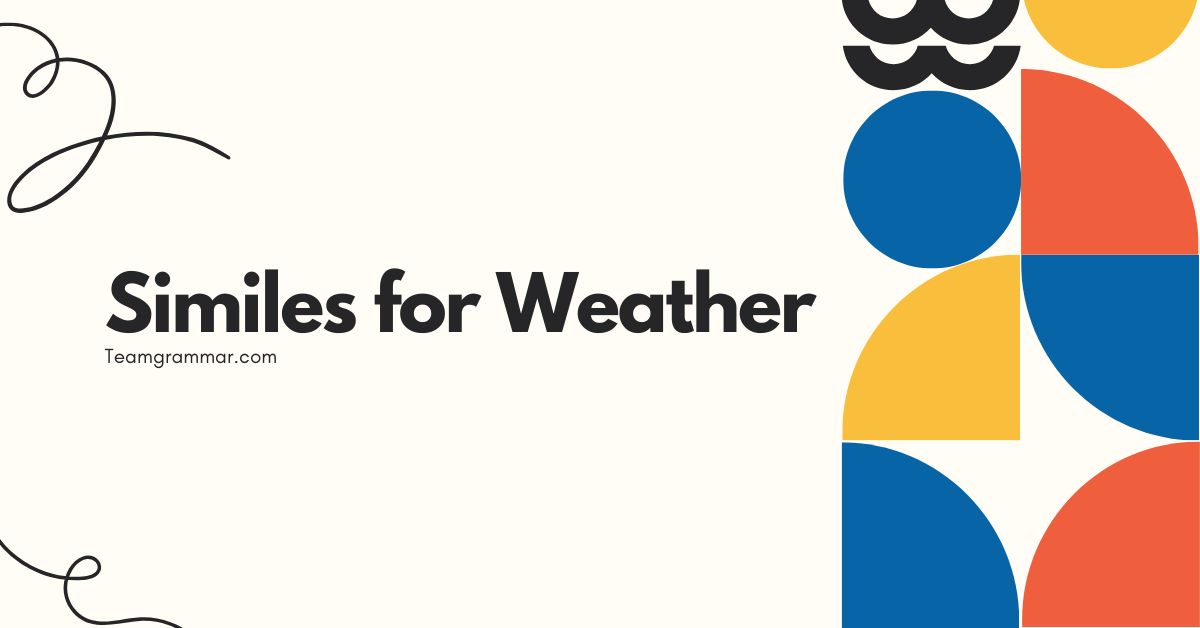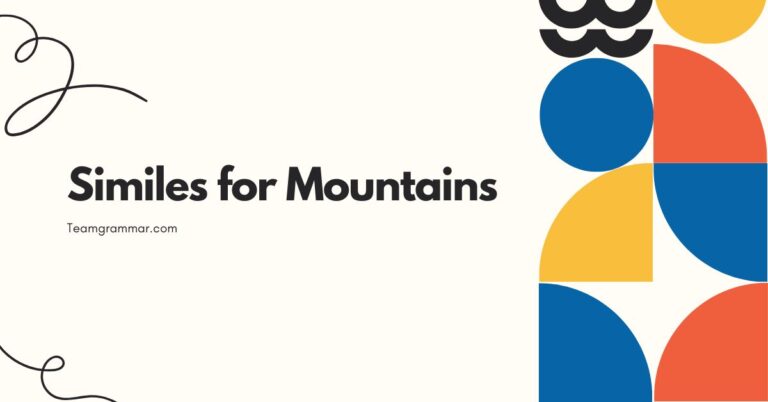47 Similes for Weather: Mastering Figurative Language
Understanding similes enhances our ability to describe the world around us vividly. This article focuses on similes used to depict weather conditions, a common yet nuanced aspect of English.
Mastering these similes not only improves your descriptive writing but also deepens your comprehension of figurative language. This guide is tailored for English language learners, writers, and anyone eager to enrich their vocabulary and expressive skills.
Definition of Simile
Asimileis a figure of speech that directly compares two different things using the words “like” or “as.” It’s a tool used to make descriptions more vivid and relatable by drawing a parallel between something familiar and something less so. Similes help to create a stronger image in the reader’s mind, making the writing more engaging and memorable.
Unlike metaphors, which state that something *is* something else, similes suggest a resemblance or similarity.
In the context of weather, similes allow us to describe atmospheric conditions in creative and imaginative ways. Instead of simply stating that it’s raining heavily, a simile could paint a picture by saying, “The rain fell like a waterfall.” This adds depth and sensory detail to the description.
Similes are a fundamental part of descriptive writing and are frequently used in literature, poetry, and everyday speech.
Structural Breakdown of Weather Similes
The basic structure of a weather simile typically follows this pattern:[Subject] + [linking word (like/as)] + [Object of Comparison]. The subject is the weather element (e.g., rain, wind, sun), and the object of comparison is something else that shares a similar quality or characteristic.
The linking word, either “like” or “as,” establishes the comparison.
Let’s break down an example: “The wind howledlikea wolf.” Here, “wind” is the subject, “like” is the linking word, and “a wolf” is the object of comparison. The simile suggests that the sound of the wind is similar to the howl of a wolf.
The effectiveness of a simile depends on the clarity and aptness of the comparison. A well-chosen simile can evoke a strong emotional response or create a vivid mental image.
The structure can sometimes be inverted for emphasis, such as: “As bright as the sun, her smile lit up the room.” While the core elements remain the same, this variation can add stylistic flair and make the simile more impactful. Understanding these structural components helps in both creating and interpreting similes effectively.
Types of Weather Similes
Weather similes can be categorized based on the specific weather element they describe. Here are some of the most common types:
Rain Similes
Rain similes often focus on the intensity, sound, or appearance of the rain. They can describe everything from a light drizzle to a torrential downpour, using comparisons to convey the specific characteristics of the rainfall.
Snow Similes
Snow similes typically highlight the appearance, texture, or movement of snow. They can evoke images of delicate snowflakes, heavy snowdrifts, or the quiet stillness of a snow-covered landscape.
Wind Similes
Wind similes describe the force, sound, or effect of the wind. They can convey the gentle breeze of a summer day or the destructive power of a hurricane.
Sun Similes
Sun similes often emphasize the warmth, brightness, or color of the sun. They can evoke feelings of joy, energy, or peace.
Storm Similes
Storm similes capture the intensity, chaos, and drama of storms. They can describe the sound of thunder, the flash of lightning, or the overall atmosphere of a storm.
Examples of Weather Similes
The following sections provide extensive examples of weather similes, categorized by weather element. Each table contains a variety of similes to illustrate the range and versatility of this figurative language technique.
Rain Similes
Rain similes are a common and effective way to describe the characteristics of rainfall. The table below provides numerous examples that cover different aspects of rain, from its intensity to its sound.
| Simile | Explanation |
|---|---|
| The rain fell like tears from the sky. | Describes the rain as resembling tears, suggesting sadness or cleansing. |
| The rain poured down like a waterfall. | Emphasizes the heavy and continuous nature of the rainfall. |
| The rain was as gentle as a whisper. | Conveys the light and soft nature of the rain. |
| The rain drummed on the roof like a thousand tiny fingers. | Focuses on the sound of the rain, creating a vivid auditory image. |
| The rain came down in sheets, like a curtain of water. | Describes the rain as a solid, unbroken mass. |
| The rain was as cold as ice. | Highlights the temperature of the rain, emphasizing its chill. |
| The rain smelled like fresh earth. | Focuses on the scent of the rain, evoking a sense of freshness. |
| The rain splattered against the window like an angry mob. | Portrays the rain as aggressive and forceful. |
| The rain pattered on the leaves like soft applause. | Creates a gentle and pleasant image of the rain. |
| The rain was as relentless as time. | Emphasizes the continuous and unstoppable nature of the rain. |
| The raindrops clung to the windowpane like diamonds. | Describes the appearance of the raindrops, highlighting their beauty. |
| The rain soaked through my clothes like a sponge. | Illustrates how quickly and thoroughly the rain saturated the clothing. |
| The rain tasted like pure, clean water. | Focuses on the taste of the rain, emphasizing its purity. |
| The rain fell like a million tiny needles. | Describes the sharp and stinging sensation of the rain. |
| The rain was as refreshing as a cool drink. | Conveys the revitalizing and pleasant effect of the rain. |
| The rain blurred the landscape like a watercolor painting. | Describes the visual effect of the rain, creating a soft and hazy image. |
| The rain washed away the dirt like a cleansing ritual. | Highlights the purifying effect of the rain. |
| The rain echoed through the streets like a mournful song. | Focuses on the sound of the rain, evoking a sense of sadness. |
| The rain danced on the rooftops like playful children. | Creates a lively and cheerful image of the rain. |
| The rain was as heavy as lead. | Emphasizes the weight and density of the rainfall. |
| The rain fell like a constant, rhythmic heartbeat. | Describes the steady and persistent nature of the rain. |
| The rain smelled like petrichor after a long drought. | Highlights the distinct, earthy scent of rain after a dry spell. |
| The rain was cold, like a forgotten memory. | Conveys the chilling sensation and a sense of nostalgia. |
| The raindrops were as big as marbles. | Emphasizes the large size of the raindrops. |
| The rain began as a drizzle, like a hesitant invitation. | Describes the initial, gentle start of the rainfall. |
| The rain ended abruptly, like a story cut short. | Illustrates the sudden cessation of the rainfall. |
| The rain was a constant companion, like a shadow. | Highlights the persistent presence of the rain. |
| The rain made the city gleam like a newly polished gem. | Describes the effect of the rain on the urban landscape. |
| The rain was as soothing as a lullaby. | Conveys the calming and relaxing effect of the rain. |
Snow Similes
Snow similes are used to vividly describe the appearance, texture, and movement of snow. The following table provides examples that capture the unique qualities of snowfall and its impact on the environment.
| Simile | Explanation |
|---|---|
| The snow fell like feathers from the sky. | Describes the gentle and light descent of the snow. |
| The snow was as white as a blank canvas. | Emphasizes the pure and pristine color of the snow. |
| The snow sparkled like diamonds in the sunlight. | Highlights the glittering and reflective quality of the snow. |
| The snow blanketed the ground like a soft quilt. | Describes the snow as covering the landscape in a comforting layer. |
| The snow crunched underfoot like broken glass. | Focuses on the sound of walking on the snow. |
| The snow was as silent as a sleeping child. | Conveys the quiet and peaceful atmosphere created by the snow. |
| The snowdrifts rose like mountains. | Emphasizes the size and scale of the snowdrifts. |
| The snowflakes melted on my skin like tiny kisses. | Creates a gentle and delicate image of the snowflakes. |
| The snow swirled around us like a ghostly dance. | Describes the swirling and ethereal movement of the snow. |
| The snow was as cold as a winter’s heart. | Highlights the intense coldness of the snow. |
| The snow stuck to the trees like icing on a cake. | Describes how the snow clings to the branches. |
| The snow transformed the landscape like a magical spell. | Emphasizes the transformative effect of the snow. |
| The snow muffled the sounds like a thick curtain. | Describes how the snow dampens noise. |
| The snow was as pure as a newborn’s soul. | Conveys the innocence and purity associated with snow. |
| The snow fell steadily, like a gentle blessing. | Describes the continuous and comforting nature of the snowfall. |
| The snow glistened under the moonlight like scattered pearls. | Highlights the shimmering and reflective quality of the snow at night. |
| The snow covered the world like a fresh start. | Emphasizes the sense of renewal and new beginnings associated with snow. |
| The snow whispered secrets as it fell. | Creates a mystical and enchanting image of the snowfall. |
| The snow clung to the branches like frozen tears. | Evokes a poignant and melancholic image of the snow. |
| The snow was as crisp as a winter apple. | Highlights the fresh and invigorating quality of the snow. |
| The snow turned the city into a winter wonderland, like a scene from a storybook. | Emphasizes the magical and enchanting effect of the snow on the urban environment. |
| The snow was as deep as a child’s imagination. | Conveys the boundless and immersive quality of the snow. |
| The snow fell like a soft, forgiving embrace. | Describes the comforting and gentle nature of the snowfall. |
| The snow was as blinding as a summer sun. | Highlights the intense brightness and reflectiveness of the snow. |
| The snow made the world feel hushed, like a library. | Emphasizes the quiet and stillness created by the snow. |
| The snow was as inviting as a warm fire on a cold night. | Conveys the sense of comfort and refuge associated with snow. |
| The snow transformed the ordinary into something extraordinary, like an artist’s touch. | Highlights the transformative and beautifying effect of the snow. |
| The snow was as fleeting as a dream. | Emphasizes the temporary and ephemeral nature of the snow. |
| The snow was like a soft, white lullaby. | Describes the calming and soothing effect of the snowfall. |
Wind Similes
Wind similes are used to describe the force, sound, and effect of the wind. They can range from gentle breezes to powerful gusts, and the following table provides examples that capture this range.
| Simile | Explanation |
|---|---|
| The wind howled like a wolf. | Describes the sound of the wind as resembling a wolf’s howl. |
| The wind was as gentle as a feather. | Conveys the light and soft nature of the wind. |
| The wind whispered through the trees like a secret. | Creates a mysterious and intimate image of the wind. |
| The wind roared like a lion. | Emphasizes the powerful and aggressive nature of the wind. |
| The wind cut through us like a knife. | Highlights the sharp and biting sensation of the wind. |
| The wind was as cold as ice. | Emphasizes the chilling temperature of the wind. |
| The wind danced through the leaves like a playful spirit. | Describes the lively and carefree movement of the wind. |
| The wind buffeted the house like an angry giant. | Portrays the wind as a strong and forceful presence. |
| The wind carried the scent of the sea like a salty kiss. | Focuses on the sensory experience of the wind. |
| The wind was as relentless as time. | Emphasizes the continuous and unstoppable nature of the wind. |
| The wind tugged at my clothes like an insistent child. | Creates a vivid and relatable image of the wind’s force. |
| The wind swept through the streets like a cleaning crew. | Describes the wind as clearing away debris. |
| The wind moaned through the trees like a mournful ghost. | Focuses on the sound of the wind, evoking a sense of sadness. |
| The wind was as unpredictable as a wild animal. | Highlights the erratic and untamed nature of the wind. |
| The wind whistled through the cracks like a playful tune. | Describes the sound of the wind as musical and lighthearted. |
| The wind whipped my hair around my face like a frenzy. | Creates a chaotic and energetic image of the wind. |
| The wind was as refreshing as a cool drink on a hot day. | Conveys the revitalizing and pleasant effect of the wind. |
| The wind carried the leaves like a swirling dance of colors. | Describes the movement of the leaves in the wind, highlighting their beauty. |
| The wind was as fierce as a storm. | Emphasizes the intense and powerful nature of the wind. |
| The wind rustled the leaves like whispered secrets. | Creates a sense of mystery and intrigue. |
| The wind was as persistent as a salesman. | Highlights the unrelenting nature of the wind. |
| The wind lifted my spirits like a kite in the sky. | Conveys the uplifting and exhilarating effect of the wind. |
| The wind was a symphony of whispers and roars. | Describes the varied and complex sounds of the wind. |
| The wind was as wild as a untamed horse. | Emphasizes the untamed and free nature of the wind. |
| The wind was the Earth’s breath, sighing through the trees. | Creates a poetic image of the wind as a vital force. |
| The wind was like a mischievous child, ruffling hair and playing tricks. | Describes the wind as playful and unpredictable. |
| The wind was as constant as the turning of the seasons. | Highlights the reliable and cyclical nature of the wind. |
| The wind was a reminder of nature’s power, like a sleeping giant. | Emphasizes the immense and potentially destructive force of the wind. |
| The wind was a storyteller, carrying tales from far away lands. | Creates a sense of adventure and travel. |
Sun Similes
Sun similes are used to describe the brightness, warmth, and color of the sun. They often evoke feelings of joy, energy, and peace.
The following table provides various examples.
| Simile | Explanation |
|---|---|
| The sun shone like a spotlight. | Emphasizes the intense and focused brightness of the sun. |
| The sun was as warm as a mother’s embrace. | Conveys the comforting and nurturing warmth of the sun. |
| The sun kissed my skin like a gentle lover. | Creates a tender and affectionate image of the sun. |
| The sun blazed like a furnace. | Highlights the intense heat of the sun. |
| The sun was as bright as a diamond. | Emphasizes the brilliant and sparkling quality of the sun. |
| The sun painted the sky like a masterpiece. | Describes the colorful and beautiful effect of the sun on the sky. |
| The sun peeked through the clouds like a shy child. | Creates a gentle and endearing image of the sun. |
| The sun beat down on us like a hammer. | Portrays the sun as a strong and forceful presence. |
| The sun was as golden as honey. | Emphasizes the rich and warm color of the sun. |
| The sun climbed higher in the sky like a determined climber. | Describes the steady and persistent movement of the sun. |
| The sun warmed my face like a friendly smile. | Conveys the pleasant and welcoming effect of the sun. |
| The sun filtered through the trees like liquid gold. | Describes the way sunlight streams through the leaves. |
| The sun was as cheerful as a summer’s day. | Emphasizes the joyful and uplifting quality of the sun. |
| The sun cast long shadows like reaching fingers. | Describes the shape and appearance of the shadows created by the sun. |
| The sun was as comforting as a familiar friend. | Conveys the sense of security and warmth associated with the sun. |
| The sun sparkled on the water like a million tiny jewels. | Highlights the shimmering and reflective quality of the sun on the water. |
| The sun was as energizing as a strong cup of coffee. | Emphasizes the revitalizing and invigorating effect of the sun. |
| The sun set behind the mountains like a fiery farewell. | Describes the dramatic and beautiful scene of the sunset. |
| The sun was as constant as hope. | Highlights the reliable and enduring nature of the sun. |
| The sun’s rays felt like a soft, warm blanket. | Conveys the comforting and enveloping sensation of the sun’s warmth. |
| The sun turned the clouds to gold, like an alchemist’s touch. | Describes the transformative and beautifying effect of the sun on the clouds. |
| The sun was as forgiving as a new day. | Emphasizes the sense of renewal and fresh starts associated with the sun. |
| The sun’s light was like a gentle hand guiding us forward. | Conveys the sense of direction and purpose provided by the sun. |
| The sun was as radiant as a bride. | Highlights the beauty and brilliance of the sun. |
| The sun’s warmth soaked into the earth, like a slow, sweet kiss. | Describes the gentle and penetrating warmth of the sun. |
| The sun was a beacon of hope in the vast expanse of the sky. | Emphasizes the guiding and reassuring presence of the sun. |
| The sun’s energy pulsed through the world, like a heartbeat. | Conveys the vital and life-sustaining power of the sun. |
| The sun was as reliable as gravity. | Highlights the dependable and unwavering nature of the sun. |
| The sun was a silent promise of a new beginning each day. | Emphasizes the sense of hope and opportunity associated with the sun. |
Storm Similes
Storm similes are used to capture the intensity, chaos, and drama of storms. They can describe the sound of thunder, the flash of lightning, or the overall atmosphere of a storm.
The following table provides a range of examples.
| Simile | Explanation |
|---|---|
| The thunder roared like a dragon. | Describes the loud and powerful sound of thunder. |
| The lightning flashed like a strobe light. | Emphasizes the bright and intermittent nature of lightning. |
| The storm raged like a furious beast. | Portrays the storm as a violent and uncontrollable force. |
| The rain lashed down like whips. | Highlights the forceful and stinging nature of the rain during a storm. |
| The wind screamed like a banshee. | Describes the high-pitched and eerie sound of the wind during a storm. |
| The storm clouds gathered like an army. | Emphasizes the imposing and threatening appearance of the storm clouds. |
| The thunder echoed through the valley like a bowling alley in the sky. | Describes the reverberating sound of thunder. |
| The lightning split the sky like a zipper. | Creates a vivid image of the lightning’s path across the sky. |
| The storm unleashed its fury like a vengeful god. | Portrays the storm as a powerful and destructive force. |
| The rain poured down like a deluge. | Emphasizes the overwhelming and torrential nature of the rainfall. |
| The wind howled like a pack of wolves. | Describes the sound of the wind as resembling the howling of wolves. |
| The storm darkened the sky like a shroud. | Emphasizes the oppressive and gloomy atmosphere of the storm. |
| The thunder rumbled like a giant’s footsteps. | Describes the deep and resonant sound of thunder. |
| The lightning illuminated the landscape like a flashbulb. | Highlights the sudden and intense brightness of the lightning. |
| The storm battered the coast like an angry sea monster. | Portrays the storm as a powerful and destructive force impacting the coastline. |
| The rain hammered on the roof like a drum solo. | Focuses on the rhythmic and intense sound of the rain during the storm. |
| The wind tore through the trees like a hurricane. | Emphasizes the destructive force of the wind during the storm. |
| The storm left a trail of destruction like a war zone. | Describes the aftermath of the storm, highlighting the damage it caused. |
| The thunder cracked like a whip. | Highlights the sharp and sudden sound of thunder. |
| The lightning danced across the sky like a celestial ballet. | Creates a beautiful and dynamic image of the lightning’s movement. |
| The storm was nature’s tantrum, wild and untamed. | Portrays the storm as an outburst of natural forces. |
| The rain fell in sheets, like a waterfall from the heavens. | Emphasizes the heavy and continuous nature of the rainfall. |
| The wind screamed through the gaps, like a tortured soul. | Describes the eerie and unsettling sound of the wind. |
| The storm was a symphony of chaos, a wild and unpredictable orchestra. | Portrays the storm as a complex and overwhelming sensory experience. |
| The lightning was like a jagged scar across the night. | Creates a striking and dramatic image of the lightning. |
| The storm was a cleansing fire, burning away the old and making way for the new. | Emphasizes the transformative and purifying effect of the storm. |
| The rain washed over the land, like tears of the sky. | Conveys a sense of sadness and catharsis. |
| The storm was a reminder of nature’s power, a force to be reckoned with. | Emphasizes the immense and potentially destructive strength of the storm. |
| The thunder was God’s bowling game. | A humorous comparison of thunder to a bowling game. |
| The storm was a fierce warrior battling the calm of the night. | Portrays the storm as an active and aggressive force. |
Usage Rules for Weather Similes
When using weather similes, it’s important to ensure that the comparison is both clear and effective. Here are some key usage rules to keep in mind:
- Choose relevant comparisons: The object of comparison should share a significant characteristic with the weather element being described. For example, comparing the sound of rain to the sound of drums is more effective than comparing it to the color blue.
- Avoid clichés: While some similes are common, overuse can make your writing sound unoriginal. Try to come up with fresh and creative comparisons.
- Maintain clarity: The simile should be easy to understand. Avoid obscure or overly complex comparisons that might confuse the reader.
- Consider the context: The appropriateness of a simile depends on the overall tone and style of your writing. A humorous simile might not be suitable for a serious or formal context.
- Ensure grammatical correctness: Make sure that the simile is grammatically sound. The subject and object of comparison should be properly linked by “like” or “as.”
Example of a good simile: “The snow fell like a soft blanket, covering the town in silence.” This simile is clear, relevant, and evokes a vivid image.
Example of a weak simile: “The rain was like a Tuesday.” This simile is vague and doesn’t create a clear or meaningful comparison.
Common Mistakes with Weather Similes
Even experienced writers sometimes make mistakes when using similes. Here are some common errors to avoid:
| Incorrect | Correct | Explanation |
|---|---|---|
| The sun is a fire. | The sun is like a fire. | The first sentence is a metaphor, not a simile. Similes require “like” or “as.” |
| The wind howled as wolf. | The wind howled like a wolf. | The correct linking word is “like,” not “as.” |
| The snow was as white than paper. | The snow was as white as paper. | The correct comparison word is “as,” not “than.” |
| The rain fell like sadness. | The rain fell like tears. | “Tears” provides a more concrete and relatable image than “sadness.” |
Overuse of Common Similes: Relying too heavily on well-known similes (e.g., “as cold as ice”) can make your writing predictable. Strive for originality.
Inconsistent Imagery: Ensure that the simile aligns with the overall imagery and mood of your piece. A jarring simile can disrupt the reader’s experience.
Practice Exercises
Test your understanding of weather similes with these exercises. Fill in the blanks to complete the similes.
| Question | Answer |
|---|---|
| 1. The rain fell ________ a waterfall. | like |
| 2. The snow was as white ________ a blank page. | as |
| 3. The wind howled ________ a wolf. | like |
| 4. The sun shone ________ a spotlight. | like |
| 5. The storm raged ________ a furious beast. | like |
| 6. The fog was ________ thick as pea soup. | as |
| 7. The hail hit the roof ________ tiny bullets. | like |
| 8. The breeze was ________ gentle as a sigh. | as |
| 9. The clouds drifted ________ ships in the sky. | like |
| 10. The heat shimmered ________ a mirage. | like |
Exercise 2: Rewrite the following sentences using similes.
| Original Sentence | Simile Sentence |
|---|---|
| 1. The rain was heavy. | The rain was as heavy as a bucket of water being dumped from the sky. |
| 2. The snow was soft. | The snow was as soft as a feather. |
| 3. The wind was cold. | The wind was as cold as ice. |
| 4. The sun was bright. | The sun shone like a spotlight. |
| 5. The storm was loud. | The storm roared like a lion. |
| 6. The fog was thick. | The fog was as thick as pea soup. |
Advanced Topics in Weather Similes
For those looking to delve deeper into the art of crafting weather similes, consider these advanced techniques:
- Synesthesia: Combine senses to create more evocative similes. For example, “The silence of the snow tasted like cold metal.”
- Personification: Give weather elements human qualities. “The wind whispered secrets like a gossiping friend.”
- Metaphorical Similes: Blend simile and metaphor for layered meaning. “The storm was like a raging beast, a metaphor for his inner turmoil.”
- Cultural References: Use similes that resonate with specific cultural contexts. This requires a deep understanding of your audience.
Experiment with these techniques to add depth and complexity to your weather similes, elevating your writing to a more sophisticated level.
FAQ: Weather Similes
Conclusion
Mastering weather similes is a valuable skill for anyone looking to enhance their descriptive writing and communication abilities. By understanding the structure, types, and usage rules of weather similes, you can create vivid and memorable images in the minds of your readers or listeners.
Practice the exercises provided, and continue to explore the creative possibilities of figurative language. With dedication and attention to detail, you can effectively use weather similes to bring your writing to life.







